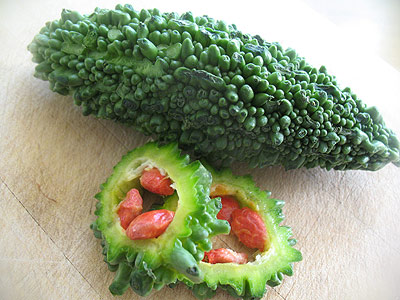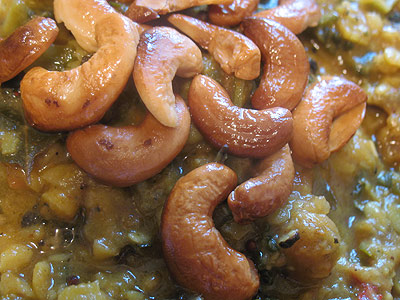May the fruit of the bitter gourd reside in every morsel of mine
~ from "Kshema Kutuhalam", an ancient Ayurvedic text as quoted by Jigyasa Giri and Pratibha Jain
If you've grown up in North America, there's a very good chance that you've never eaten bitter melons, if in fact you've even heard of them — and that would be a shame. Also known as bitter gourds, bitter melons have a fresh crunch that tastes like something between zucchini and cucumber — except, of course, far more bitter. But while deserving of their name, bitter melons are also powerhouses of nutritional and healing benefits that are highly esteemed in India and much of Asia, where the vegetable is considered a tonic for stomach complaints and the listless appetites of the elderly and the sick. Also considered to have anti-viral, anti-anemic and even anti-diabetic properties, you don't need to be suffering any maladies to enjoy a rich source of iron, beta carotene, calcium and potassium and good source of fiber, phosphorus and vitamins A, B1, B2, B3 and C that should give bitter melons a prominent place in any nutritionist's dossier.
Fortunately, bitter melons are also widely available here in any Indian or Chinese grocer, and the bitter taste — difficult to acquire on its own — is easily moderated by cooking with rich and spicy flavors as in this hearty and colorful sambar, adapted from Chandra Padmanabhan's delightful compendium of South Indian cooking "Dakshin"
As with toor dal, tamarind, jaggery and other ingredients in this recipe, bitter melons are easily found in Indian and Asian grocers. The immature fruits of a vine plant, Indian bitter melons are not difficult to identify by appearance — short green oval gourds with a skin covered with "warts" and ridges. Chinese bitter melons have a paler and less stippled appearance — either variety can be used, and first comers may want to consider that Chinese bitter melons are a little less bitter in taste. Avoid bitter melons that are starting to turn yellow — these should be discarded — and refrigerate in a plastic bag no more than a few days before cutting and using. Gently wash the skins of the gourds, cut off the ends, and slice lengthwise to scrape out the seeds and fibrous tissue before chopping and cooking.
One further note — good commercial brands of sambar masala or sambar powder are also easily available at Indian grocers, but to get the vibrancy of a spice blend made fresh at home, just follow this very simple recipe here.
 Bitter Melon (Bitter Gourd) Sambar Bitter Melon (Bitter Gourd) Sambar |
| Recipe by Lisa Turner Adapted from Dakshin Cuisine: Indian Published on December 5, 2011 A spicy and very healthy South Indian curry made with bitter melons, one of the most extraordinary and beneficial vegetables Preparation: 20 minutes Cooking time: 1 hour  Print this recipe Print this recipeIngredients:
|
Other South Indian sambar recipes from Lisa's Kitchen:
Homemade Sambar Masala Powder
Butternut Squash Sambar
Carrot Sambar
Black-Eyed Pea Sambar
On the top of the reading stack: Healthy Eating Healthy World
by J Morris Hicks




7 comments:
I wondered what those things are. I see them in the small ethnic grocery stores close by where I live in Toronto. Now I know what they are ... and how to cook them up. Thank you, Lisa.
Looks delicious! need to try this! bookmarked for later used! thanks for the great recipe!
I've never seen them or eaten them (as far as I can remember) - they look so pretty that I want to try them - so will keep your advice and your recipe in mind for if and when I find one
Just love bittergourd,sambar is one of my fav dish with bittergourd,looks invitign.
The one time I had bitter melon, it was so bitter it tasted like aspirin. I am not kidding. Is it suppose to be that bitter? Or did we have a "bad" batch with ignorant cooks compounding the problem?
Hi Kaede,
The older bitter melons get, the more bitter they become. Look for bright green bitter melons, use as soon as possible, and once the seeds turn red they may be too bitter for your taste. Cooks may also want to reduce the amount of bitter melons in a recipe until you're more accustomed to the taste. I hope you have more pleasant experiences with the vegetable in the future.
I don't know about the taste but the fruit is beautiful!
Post a Comment